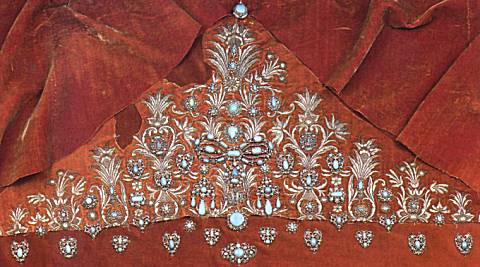
| ANNE WANNER'S Textiles in History / book reviews, articles |
Die Votivgewänder des Kurfürsten
Clemens August für die Telgter Madonna, by Dela
von Boeselager, Sonderdruck aus: Kölner Domblatt,
Jahrbuch des Zentral-Dombau-Vereins, 2005, S. 181 - 200;
20 pages, 10 colour illustrations, in german |
|
| In her article Dela von
Boeselager researches the history of the donation of
vestments to the Madonna of Teltge, a place of pilgrimage
in the diocese of Muenster in Westphalia. A series of
written sources, previously unknown, now let us
recontruct the story of this votive gift. Today fragments of the vestment in question can be found in the Museum "Heimathaus Muensterland" at Teltge. Since 1854 the vestment was out of use because of a renovation of the statue of the Virgin and the fabbric probably was given as relics to pilgrims piece by piece . In the museum the 58 jewels sewn on the velvet are still completely preserved. The city of Teltge was the most important place of
pilgrimage in the diocese of Muenster in Westphalia. A
chapel was built and regular processions were introduced.
As a result the prigrimage to the Pieta was very much
booming from 1654 to 1657. Since 1719 it was the
archbishop Clemens August to reign in this diocese and he
promoted the worship of the Madonna in this place. (He
was one of the sovereigns who had a right to participate
in the election of the emperor, and in German his title
was "Kurfürst"). The jeweller Barre set up 58
turquoises from Clemens August's mothers jewels on flat
rings with small eyes in it for sewing them onto the
fabbric. The gold embroiderer Anton Schicker
(or Schecker) was commissioned to insert them in the
metal embroidery on red velvet. The payment accounts of
these 2 craftsmen date from 1732. The question whether the jewels once belonged to the
bridal jewels of Therese Kunigunde is not cleared yet.
Dela von Boeselager did not find any proves for this.
Turquoises were popular in the Ottoman Empire. In Europe
of this time diamonds were more in fashion. The jewels
could have been donated to Therese Kunigunde by her
husband or by her father. Both were much clelebrated as
conquerors over the Turks. |
|
| home content | Last revised 18 March, 2006 | For further information contact Anne Wanner wanner@datacomm.ch |